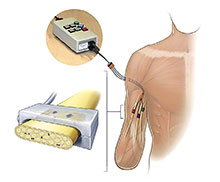
Implanted peripheral nerve electrodes deliver stimulation directly to the nerve. Image courtesy of Graczyk et al., Science Translational Medicine.
Scientists at the University of Chicago (UChicago) and Case Western Reserve University (CWRU) have produced realistic sensations of touch in two subjects with upper-limb amputations by directly stimulating the nervous system. The study, published October 26 in Science Translational Medicine (STM), confirms earlier research on how the nervous system encodes the intensity, or magnitude, of sensations. It is the second of two publications this month by neuroscientist Sliman Bensmaia, PhD, an associate professor with the UChicago Department of Organismal Biology and Anatomy, using neuroprosthetic devices to recreate the sense of touch for patients with amputations or quadriplegia with a biomimetic approach that approximates the natural, intact nervous system.
The study takes a similar approach in patients with amputations that was used previously in a patient with quadriplegia. In this new case, two male subjects who each lost an arm after traumatic injuries were implanted with neural interfaces embedded with electrodes that were attached to the median, ulnar, and radial nerves of their residual limbs. Those are the same nerves that would carry signals from the hand were it still intact.
“If you want to create a dexterous hand for use in an amputee or a quadriplegic patient, you need to not only be able to move it, but have sensory feedback from it,” said Bensmaia. “To do this, we first need to look at how the intact hand and the intact nervous system encodes this information, and then, to the extent that we can, try to mimic that in a neuroprosthesis.”
The latest research is a joint effort by Bensmaia and Dustin Tyler, PhD, the Kent H. Smith Professor of Biomedical Engineering at CWRU, who works with a team trying to make bionic hands clinically viable. Tyler’s team, led by doctoral student Emily Graczyk, systematically tested the subjects’ ability to distinguish the magnitude of the sensations evoked when their nerves were stimulated through the interface. They varied aspects of the signals, such as frequency and intensity of each electrical pulse. The goal was to understand if there was a systematic way to manipulate the sensory magnitude.
Results from the new study verify a prior hypothesis from Bensmaia: A single feature of electrical stimulation-dubbed the activation charge rate-was found to determine the strength of the sensation. By changing the activation charge rate, the team could change sensory magnitude in a highly predictable way. The team then showed that the activation charge rate was also closely related to the evoked population spike rate.
While the new study furthers the development of neural interfaces for neuroprosthetics, artificial touch will only be as good as the devices providing input. In a separate paper published earlier this year in IEEE Transactions on Haptics, Bensmaia and his team tested the sensory abilities of a robotic fingertip equipped with touch sensors. Using the same behavioral techniques that are used to test human sensory abilities, Bensmaia’s team tested the finger’s ability to distinguish different touch locations, different pressure levels, the direction and speed of surfaces moving across it, and the identity of textures scanned across it. The robotic finger, with the help of machine learning algorithms, proved to be almost as good as a human at most of those sensory tasks. By combining such high-quality input with the algorithms and data Bensmaia and Tyler produced in the other study, researchers can begin building neuroprosthetics that approximate natural sensations of touch, researchers said.
“The idea is that if we can reproduce those signals exactly, the amputee won’t have to think about it, he can just interact with objects naturally and automatically. Results from this study constitute a first step towards conveying finely graded information about contact pressure,” Bensmaia said.
Editor’s note: This story was adapted from materials provided by UChicago.




